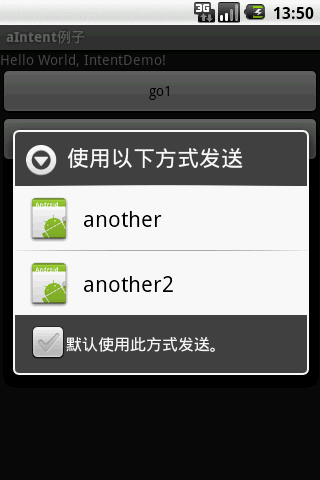一、 Intent 作用
Intent 是一个将要执行的动作的抽象的描述,一般来说是作为参数来使用,由Intent来协助完成android各个组件之间的通讯。比如说调用startActivity()来启动一个activity,或者由broadcaseIntent()来传递给所有感兴趣的BroadcaseReceiver, 再或者由startService()/bindservice()来启动一个后台的service.所以可以看出来,intent主要是用来启动其他的activity 或者service,所以可以将intent理解成activity之间的粘合剂。
要在不同的activity之间传递数据,就要在intent中包含相应的东西,一般来说数据中最基本的应该包括:
Action 用来指明要实施的动作是什么,比如说ACTION_VIEW, ACTION_EDIT等。具体的可以查阅android SDK-> reference中的Android.content.intent类,里面的constants中定义了所有的action。
Data 要事实的具体的数据,一般由一个Uri变量来表示 ,下面是一些简单的例子:
ACTION_VIEW content://contacts/1 //显示identifier为1的联系人的信息。
ACTION_DIAL content://contacts/1 //给这个联系人打电话
除了Action和data这两个最基本的元素外,intent还包括一些其他的元素,
Category(类别): 这个选项指定了将要执行的这个action的其他一些额外的信息,例如 LAUNCHER_CATEGORY 表示Intent 的接受者应该在Launcher中作为顶级应用出现;而ALTERNATIVE_CATEGORY表示当前的Intent是一系列的可选动作中的一个,这些动作可以在同一块数据上执行。具体同样可以参考android SDK-> reference中的Android.content.intent类。
Type(数据类型):显式指定Intent的数据类型(MIME)。一般Intent的数据类型能够根据数据本身进行判定,但是通过设置这个属性,可以强制采用显式指定的类型而不再进行推导。
component(组件):指定Intent的的目标组件的类名称。通常 Android会根据Intent 中包含的其它属性的信息,比如action、data/type、category进行查找,最终找到一个与之匹配的目标组件。但是,如果 component这个属性有指定的话,将直接使用它指定的组件,而不再执行上述查找过程。指定了这个属性以后,Intent的其它所有属性都是可选的。
extras(附加信息),是其它所有附加信息的集合。使用extras可以为组件提供扩展信息,比如,如果要执行“发送电子邮件”这个动作,可以将电子邮件的标题、正文等保存在extras里,传给电子邮件发送组件。
下面是这些额外属性的几个例子:
ACTION_MAIN with category CATEGORY_HOME //用来 Launch home screen.
ACTION_GET_CONTENT with MIME type vnd.android.cursor.item/phone //用来列出列表中的所有人的电话号码
综上可以看出,action、 data/type、category和extras 一起形成了一种语言,这种语言可以是android可以表达出诸如“给张三打电话”之类的短语组合
三、 intent的解析
应用程序的组件为了告诉Android自己能响应、处理哪些隐式Intent请求,可以声明一个甚至多个Intent Filter。每个Intent Filter描述该组件所能响应Intent请求的能力——组件希望接收什么类型的请求行为,什么类型的请求数据。比如之前请求网页浏览器这个例子中,网页浏览器程序的Intent Filter就应该声明它所希望接收的Intent Action是WEB_SEARCH_ACTION,以及与之相关的请求数据是网页地址URI格式。如何为组件声明自己的Intent Filter? 常见的方法是在AndroidManifest.xml文件中用属性< Intent-Filter>描述组件的Intent Filter。
前面我们提到,隐式Intent(Explicit Intents)和Intent Filter(Implicit Intents)进行比较时的三要素是Intent的动作、数据以及类别。实际上,一个隐式Intent请求要能够传递给目标组件,必要通过这三个方面的检查。如果任何一方面不匹配,Android都不会将该隐式Intent传递给目标组件。接下来我们讲解这三方面检查的具体规则。
动作测试
Java代码
< intent-filter>元素中可以包括子元素< action>,比如:
< intent-filter> < action android:name=”com.example.project.SHOW_CURRENT” />
< action android:name=”com.example.project.SHOW_RECENT” />
< action android:name=”com.example.project.SHOW_PENDING” />
< /intent-filter>
一条< intent-filter>元素至少应该包含一个< action>,否则任何Intent请求都不能和该< intent-filter>匹配。如果Intent请求的Action和< intent-filter>中个某一条< action>匹配,那么该Intent就通过了这条< intent-filter>的动作测试。如果Intent请求或< intent-filter>中没有说明具体的Action类型,那么会出现下面两种情况。
(1) 如果< intent-filter>中没有包含任何Action类型,那么无论什么Intent请求都无法和这条< intent- filter>匹配;
(2) 反之,如果Intent请求中没有设定Action类型,那么只要< intent-filter>中包含有Action类型,这个 Intent请求就将顺利地通过< intent-filter>的行为测试。
类别测试
Java代码
< intent-filter>元素可以包含< category>子元素,比如:
< intent-filter . . . >
< category android:name=”android.Intent.Category.DEFAULT” />
< category android:name=”android.Intent.Category.BROWSABLE” />
< /intent-filter>
只有当Intent请求中所有的Category与组件中某一个IntentFilter的< category>完全匹配时,才会让该 Intent请求通过测试,IntentFilter中多余的< category>声明并不会导致匹配失败。一个没有指定任何类别测试的 IntentFilter仅仅只会匹配没有设置类别的Intent请求。
数据测试
数据在< intent-filter>中的描述如下: Java代码
< intent-filter . . . >
< data android:type=”video/mpeg” android:scheme=”http” . . . />
< data android:type=”audio/mpeg” android:scheme=”http” . . . />
< /intent-filter>
元素指定了希望接受的Intent请求的数据URI和数据类型,URI被分成三部分来进行匹配:scheme、 authority和path。其中,用setData()设定的Inteat请求的URI数据类型和scheme必须与IntentFilter中所指定的一致。若IntentFilter中还指定了authority或path,它们也需要相匹配才会通过测试。
简单例子说明
讲解完Intent基本概念之后,接下来我们就使用Intent激活Android自带的电话拨号程序,通过这个实例你会发现,使用Intent并不像其概念描述得那样难。最终创建Intent的代码如下所示。
Intent i = new Intent(Intent.ACTION_DIAL,Uri.parse(”tel://13800138000″));
创建好Intent之后,你就可以通过它告诉Android希望启动新的Activity了。
startActivity(i);
Activity启动后显示界面如下:

四、Intent的构造函数
公共构造函数:
1、Intent() 空构造函数
2、Intent(Intent o) 拷贝构造函数
3、Intent(String action) 指定action类型的构造函数
4、Intent(String action, Uri uri) 指定Action类型和Uri的构造函数,URI主要是结合程序之间的数据共享ContentProvider
5、Intent(Context packageContext, Class<?> cls) 传入组件的构造函数,也就是上文提到的
6、Intent(String action, Uri uri, Context packageContext, Class<?> cls) 前两种结合体
Intent有六种构造函数,3、4、5是最常用的,并不是其他没用!
Intent(String action, Uri uri) 的action就是对应在AndroidMainfest.xml中的action节点的name属性值。在Intent类中定义了很多的Action和Category常量。
示例代码二:
1: Intent intent = new Intent(Intent.ACTION_EDIT, null);
2: startActivity(intent);
示例代码二是用了第四种构造函数,只是uri参数为null。执行此代码的时候,系统就会在程序主配置文件AndroidMainfest.xml中寻找<action android:name="android.intent.action.EDIT" />对应的Activity,如果对应为多个activity具有<action android:name="android.intent.action.EDIT" />此时就会弹出一个dailog选择Activity,如下图:
如果是用示例代码一那种方式进行发送则不会有这种情况。
五、利用Intent在Activity之间传递数据
在Main中执行如下代码:
1: Bundle bundle = new Bundle();
2: bundle.putStringArray("NAMEARR", nameArr);
3: Intent intent = new Intent(Main.this, CountList.class);
4: intent.putExtras(bundle);
5: startActivity(intent);
在CountList中,代码如下:
1: Bundle bundle = this.getIntent().getExtras();
2: String[] arrName = bundle.getStringArray("NAMEARR");
以上代码就实现了Activity之间的数据传递!
Android intent intent-filter
六、总结说明
这篇文章是我刚开始学习Android时看到的,当时理解的不是很深入,现在再回头看这篇文章总结的很详细,在这里与大家分享。
1,掉web浏览器
Java代码
Uri myBlogUri = Uri.parse("http://kuikui.javaeye.com");
returnIt = new Intent(Intent.ACTION_VIEW, myBlogUri);
Java代码
Uri mapUri = Uri.parse("geo:38.899533,-77.036476");
returnIt = new Intent(Intent.ACTION_VIEW, mapUri);
3,调拨打电话界面
Java代码
Uri telUri = Uri.parse("tel:100861");
returnIt = new Intent(Intent.ACTION_DIAL, telUri);
4,直接拨打电话
Java代码
Uri callUri = Uri.parse("tel:100861");
returnIt = new Intent(Intent.ACTION_CALL, callUri);
5,卸载
Java代码
Uri uninstallUri = Uri.fromParts("package", "xxx", null);
returnIt = new Intent(Intent.ACTION_DELETE, uninstallUri);
6,安装
Java代码
Uri installUri = Uri.fromParts("package", "xxx", null);
returnIt = new Intent(Intent.ACTION_PACKAGE_ADDED, installUri);
7,播放
Java代码
Uri playUri = Uri.parse("file:///sdcard/download/everything.mp3");
returnIt = new Intent(Intent.ACTION_VIEW, playUri);
8,掉用发邮件
Java代码
Uri emailUri = Uri.parse("mailto:shenrenkui@gmail.com");
returnIt = new Intent(Intent.ACTION_SENDTO, emailUri);
9,发邮件
Java代码
returnIt = new Intent(Intent.ACTION_SEND);
String[] tos = { "shenrenkui@gmail.com" };
String[] ccs = { "shenrenkui@gmail.com" };
returnIt.putExtra(Intent.EXTRA_EMAIL, tos);
returnIt.putExtra(Intent.EXTRA_CC, ccs);
returnIt.putExtra(Intent.EXTRA_TEXT, "body");
returnIt.putExtra(Intent.EXTRA_SUBJECT, "subject");
returnIt.setType("message/rfc882");
Intent.createChooser(returnIt, "Choose Email Client");
10,发短信 Java代码
Uri smsUri = Uri.parse("tel:100861");
returnIt = new Intent(Intent.ACTION_VIEW, smsUri);
returnIt.putExtra("sms_body", "shenrenkui");
returnIt.setType("vnd.android-dir/mms-sms");
11,直接发邮件
Java代码
Uri smsToUri = Uri.parse("smsto://100861");
returnIt = new Intent(Intent.ACTION_SENDTO, smsToUri);
returnIt.putExtra("sms_body", "shenrenkui");
12,发彩信
Java代码
Uri mmsUri = Uri.parse("content://media/external/images/media/23");
returnIt = new Intent(Intent.ACTION_SEND);
returnIt.putExtra("sms_body", "shenrenkui");
returnIt.putExtra(Intent.EXTRA_STREAM, mmsUri);
returnIt.setType("image/png");
用获取到的Intent直接调用startActivity(returnIt)就ok了。
实例
下面,以Android SDK中的便笺例子来说明,Intent如何定义及如何被解析。这个应用可以让用户浏览便笺列表、查看每一个便笺的详细信息。
Manifest.xml
Xml代码
1. <manifest xmlns:android="http://schemas.android.com/apk/res/android"
2. package="com.google.android.notepad">
3. <application android:icon="@drawable/app_notes"
4. android:label="@string/app_name">
5. <provider class="NotePadProvider"
6. android:authorities="com.google.provider.NotePad" />
7. <activity class=".NotesList"="@string/title_notes_list">
8. <intent-filter>
9. <action android:value="android.intent.action.MAIN"/>
10. <category android:value="android.intent.category.LAUNCHER" />
11. </intent-filter>
12. <intent-filter>
13. <action android:value="android.intent.action.VIEW"/>
14. <action android:value="android.intent.action.EDIT"/>
15. <action android:value="android.intent.action.PICK"/>
16. <category android:value="android.intent.category.DEFAULT" />
17. <type android:value="vnd.android.cursor.dir/vnd.google.note" />
18. </intent-filter>
19. <intent-filter>
20. <action android:value="android.intent.action.GET_CONTENT" />
21. <category android:value="android.intent.category.DEFAULT" />
22. <type android:value="vnd.android.cursor.item/vnd.google.note" />
23. </intent-filter>
24. </activity>
25. <activity class=".NoteEditor"="@string/title_note">
26. <intent-filter android:label="@string/resolve_edit">
27. <action android:value="android.intent.action.VIEW"/>
28. <action android:value="android.intent.action.EDIT"/>
29. <category android:value="android.intent.category.DEFAULT" />
30. <type android:value="vnd.android.cursor.item/vnd.google.note" />
31. </intent-filter>
32. <intent-filter>
33. <action android:value="android.intent.action.INSERT"/>
34. <category android:value="android.intent.category.DEFAULT" />
35. <type android:value="vnd.android.cursor.dir/vnd.google.note" />
36. </intent-filter>
37. </activity>
38. <activity class=".TitleEditor"="@string/title_edit_title"
39.android:theme="@android:style/Theme.Dialog">
40. <intent-filter android:label="@string/resolve_title">
41. <action android:value="com.google.android.notepad.action.EDIT_TITLE"/>
42. <category android:value="android.intent.category.DEFAULT" />
43. <category android:value="android.intent.category.ALTERNATIVE" />
44. <category android:value="android.intent.category.SELECTED_ALTERNATIVE"/>
45. <type android:value="vnd.android.cursor.item/vnd.google.note" />
46. </intent-filter>
47. </activity>
48.</application>
49.</manifest>
例子中的第一个Activity 是com.google.android.notepad.NotesList,它是应用的主入口,提供了三个功能,分别由三个 intent-filter进行描述:
1、第一个是进入便笺应用的顶级入口(action为android.app.action.MAIN)。类型为android.app.category.LAUNCHER表明这个Activity将在Launcher中列出。
2、第二个是,当type为vnd.android.cursor.dir/vnd.google.note(保存便笺记录的目录)时,可以查看可用的便笺(action为android.app.action.VIEW),或者让用户选择一个便笺并返回给调用者(action为 android.app.action.PICK)。
3、第三个是,当type为vnd.android.cursor.item/vnd.google.note时,返回给调用者一个用户选择的便笺(action为android.app.action.GET_CONTENT),而用户却不需要知道便笺从哪里读取的。有了这些功能,下面的Intent就会被解析到NotesList这个activity:
* { action=android.app.action.MAIN }:与此Intent匹配的Activity,将会被当作进入应用的顶级入口。
* { action=android.app.action.MAIN, category=android.app.category.LAUNCHER }:这是目前Launcher实际使用的 Intent,用于生成Launcher的顶级列表。
* { action=android.app.action.VIEW data=content://com.google.provider.NotePad/notes }:显示"content://com.google.provider.NotePad/notes"下的所有便笺的列表,使用者可以遍历列表,并且察看某便笺的详细信息。
* { action=android.app.action.PICK data=content://com.google.provider.NotePad/notes }:显示"content://com.google.provider.NotePad/notes"下的便笺列表,让用户可以在列表中选择一个,然后将选择的便笺的 URL返回给调用者。
* { action=android.app.action.GET_CONTENT type=vnd.android.cursor.item/vnd.google.note }:和上面的action为pick的Intent类似,不同的是这个Intent允许调用者(在这里指要调用NotesList的某个Activity)指定它们需要返回的数据类型,系统会根据这个数据类型查找合适的 Activity(在这里系统会找到NotesList这个Activity),供用户选择便笺。
第二个Activity是com.google.android.notepad.NoteEditor,它为用户显示一条便笺,并且允许用户修改这个便笺。它定义了两个intent-filter,所以具有两个功能。第一个功能是,当数据类型为 vnd.android.cursor.item/vnd.google.note时,允许用户查看和修改一个便签(action为 android.app.action.VIEW和android.app.action.EDIT)。第二个功能是,当数据类型为 vnd.android.cursor.dir/vnd.google.note,为调用者显示一个新建便笺的界面,并将新建的便笺插入到便笺列表中(action为android.app.action.INSERT)。
有了这两个功能,下面的Intent就会被解析到NoteEditor这个activity:
* { action=android.app.action.VIEW data=content://com.google.provider.NotePad/notes/{ID} } :向用户显示标识为 ID的便笺。
* { action=android.app.action.EDIT data=content://com.google.provider.NotePad/notes/{ID} }:允许用户编辑标识为ID的便笺。
* { action=android.app.action.INSERT data=content://com.google.provider.NotePad/notes }:在“content://com.google.provider.NotePad/notes”这个便笺列表中创建一个新的空便笺,并允许用户编辑这个便签。当用户保存这个便笺后,这个新便笺的URI将会返回给调用者。
最后一个Activity是com.google.android.notepad.TitleEditor,它允许用户编辑便笺的标题。它可以被实现为一个应用可以直接调用(在Intent中明确设置component属性)的类,不过这里我们将为你提供一个在现有的数据上发布可选操作的方法。在这个 Activity的唯一的intent-filter中,拥有一个私有的action: com.google.android.notepad.action.EDIT_TITLE,表明允许用户编辑便笺的标题。和前面的view和edit 动作一样,调用这个Intent 的时候,也必须指定具体的便笺(type为vnd.android.cursor.item/vnd.google.note)。不同的是,这里显示和编辑的只是便笺数据中的标题。
除了支持缺省类别(android.intent.category.DEFAULT),标题编辑器还支持另外两个标准类别: android.intent.category.ALTERNATIVE和 android.intent.category.SELECTED_ALTERNATIVE。实现了这两个类别之后,其它 Activity就可以调用queryIntentActivityOptions(ComponentName, Intent[], Intent, int)查询这个Activity提供的action,而不需要了解它的具体实现;或者调用addIntentOptions(int, int, ComponentName, Intent[], Intent, int, Menu.Item[])建立动态菜单。需要说明的是,在这个intent-filter中有一个明确的名称(通过android:label= "@string/resolve_title"指定),在用户浏览数据的时候,如果这个Activity是数据的一个可选操作,指定明确的名称可以为用户提供一个更好控制界面。
有了这个功能,下面的Intent就会被解析到TitleEditor这个Activity:
* { action=com.google.android.notepad.action.EDIT_TITLE data=content://com.google.provider.NotePad/notes/{ID} }:显示并且允许用户编辑标识为ID的便笺的标题。






相关推荐
Intent在Android开发中扮演着至关重要的角色,它是四大组件(Activity、Service、BroadcastReceiver和ContentProvider)间通信的关键。Intent不仅用于应用间的交互,也可以在同一个应用内的不同组件之间传递信息。...
本文档主要讲述的是Android_Intent详解;Intent 是一个将要执行的动作的抽象的描述,一般来说是作为参数来使用,由Intent来协助完成android各个组件之间的通讯。比如说调用startActivity()来启动一个activity,或者由...
android Activity& android Intent详解, 入门级别
### Android Intent详解 #### 一、Intent的作用与概念 **Intent** 在Android开发中扮演着极为重要的角色,它是实现Android应用程序内部以及不同应用程序之间通信的关键工具。简而言之,Intent可以被视为一种消息...
【Android Intent和Intent Filter详解】 Intent是Android系统中用于组件间通信的重要机制,它描述了想要执行的操作和可能涉及的数据。Intent对象包含了组件信息、动作(Action)、数据(Data)、类别(Category)...
### Android Intent 详解 #### 一、Intent 的作用 `Intent` 在 Android 开发中扮演着极其重要的角色,它是用于启动或与应用组件(如 Activity、Service 或 BroadcastReceiver)交互的一种方式。简而言之,`Intent`...
Android-Intent详解.doc
Android Intent 详解 Android Intent 是 Android 应用程序中的一种机制,用于在应用程序组件之间进行通讯和交互。 Intent 负责对应用中一次操作的动作、动作涉及数据、附加数据进行描述,Android 则根据此 Intent ...
### ZX-Android-Intent详解 #### 一、Intent的基本概念及作用 在Android开发中,`Intent`扮演着至关重要的角色。它是一个用于描述要执行的动作的抽象对象,主要用于协助完成Android应用程序内部不同组件间的通信。...
Intent详解(二)源码分析 Intent在Android系统中扮演着至关重要的角色,它是应用程序间通信(IPC,Inter-Process Communication)的主要手段。Intent不仅用于启动活动(Activity)、服务(Service),还可以用来...
Android 页面跳转和 Intent 详解,Bundle 类介绍说明 Android 页面跳转是移动应用程序中的一种基本交互方式,通过 Intent 和 Activity 两个组件来实现。Intent 是 Android 中的一个核心组件,用于在不同的 Activity...
在sendBroadcast,startActivity时,我们会用到Intent。 Intent可以携带一些数据,比如基本类型数据int、Boolean,或是String,或是序列化对象,Parcelable与Serializable。 Intent传递数据时,如果数据太大,可能...
### Android Intent 机制详解 #### 一、Intent 的基本概念 **Intent** 是 Android 四大应用组件(Activity、Service、Broadcast Receiver 和 Content Provider)之间通信的重要桥梁。它是一种消息对象,用来描述一...
标题与描述均指向了“Android各组件详解——Intent”,这一主题深入探讨了Android开发中至关重要的Intent组件。本文将从多个角度解析Intent的功能、应用场景及其内部结构,为开发者提供全面的理解。 ### Intent概述...
在Android开发中,Intent机制扮演着至关重要的角色,它是Android应用程序组件间通信的主要桥梁。Intent不仅用于启动活动(Activity)、服务(Service),还可以传递数据和触发广播接收器(Broadcast Receiver)。...
**Android Intent机制详解** Intent是Android系统中一个至关重要的组件,它是应用程序间以及应用程序内部组件(如Activity和服务Service)通信的主要桥梁。Intent不仅用于不同应用之间的交互,还用于在同一应用内的...
在Android应用开发中,Intent是一种强大的机制,它用于在组件之间传递消息,是应用程序中不同组件(如Activity、Service、BroadcastReceiver)之间交互的核心工具。Intent不仅能够启动其他组件,还可以用于在组件间...
“Android 隐式Intent 的实例详解” Android 隐式Intent 是一种特殊的 Intent,用于在不明确设置激活对象的前提下寻找最匹配的组件。它的核心思想是通过在 AndroidManifest.xml 文件中设置意图过滤器,来指定 ...
Android Intent和Intent_Filter详解 Android Intent是 Android 组件间通信的载体,它们之间的通信是通过 Intent 对象在不断传递实现的。Android 的三大核心组件 Activity、Service 和 BroadcastReceiver 都是通过 ...